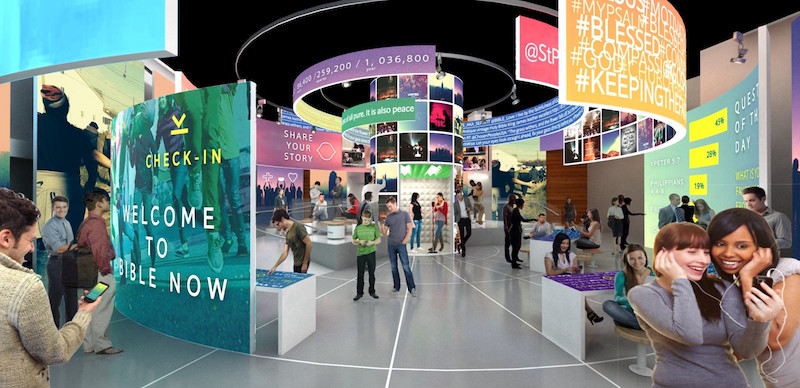The 430,000-sf Museum of the Bible is currently under construction in Washington, D.C., and when completed, will provide visitors with an immersive experience teaching the history, narrative, and impact of the Bible.
The eight-story building will feature 40-foot-tall bronze doors at the main entrance and a garden on the building’s roof. Between the front doors and the garden, the museum will be packed with cutting-edge technology that helps to span time, space, and cultures in teaching the history of the bible.
The first floor will include a gift shop, children’s area, 12,500-sf of temporary exhibition space, permanent library space, and storage space. The second floor will feature research labs and libraries and The Impact of the Bible exhibition. The third floor features The Narratives of the Bible and Nazareth Village exhibitions. On the fourth floor you will find an exhibition named The History of the Bible. Permanent exhibition space, a 500-seat theater, 100-seat lecture hall, classrooms, and offices will be located on the fifth floor. Finally, the sixth floor will feature a gathering room and the Biblical Gardens Restaurant.
The Impact Floor (floor 2) will be highly interactive and use advanced technology to help tell the stories of the impact the Bible has had on the world.
The Narrative Floor (floor 3) intertwines immersive experiences with artifacts as visitors walk through the narratives of the Hebrew text from Genesis to Chronicles, then first-century Nazareth, and finally the New Testament.
The History Floor (floor 4) will feature more than 500 artifacts that document the Bible’s preservation, translation, and transmission across centuries. Some of the artifacts include writings dating to the time of Abraham, fragments of the Dead Sea Scrolls, and early New Testament writings.
The museum is scheduled to open in Fall 2017.
 Rendering courtesy of C&GPartners
Rendering courtesy of C&GPartners
Related Stories
| Sep 12, 2011
Living Buildings: Are AEC Firms up to the Challenge?
Modular Architecture > You’ve done a LEED Gold or two, maybe even a LEED Platinum. But are you and your firm ready to take on the Living Building Challenge? Think twice before you say yes.
| Apr 13, 2011
Expanded Museum of the Moving Image provides a treat for the eyes
The expansion and renovation of the Museum of the Moving Image in the Astoria section of Queens, N.Y., involved a complete redesign of its first floor and the construction of a three-story 47,000-sf addition.
| Apr 12, 2011
Entrance pavilion adds subtle style to Natural History Museum of Los Angeles
A $13 million gift from the Otis Booth Foundation is funding a new entrance pavilion at the Natural History Museum of Los Angeles County. CO Architects, Los Angeles, is designing the frameless structure with an energy-efficient curtain wall, vertical suspension rods, and horizontal knife plates to make it as transparent as possible.
| Jan 21, 2011
Sustainable history center exhibits Fort Ticonderoga’s storied past
Fort Ticonderoga, in Ticonderoga, N.Y., along Lake Champlain, dates to 1755 and was the site of battles in the French and Indian War and the American Revolution. The new $20.8 million, 15,000-sf Deborah Clarke Mars Education Center pays homage to the French magasin du Roi (the King’s warehouse) at the fort.
| Jan 19, 2011
Industrial history museum gets new home in steel plant
The National Museum of Industrial History recently renovated the exterior of a 1913 steel plant in Bethlehem, Pa., to house its new 40,000-sf exhibition space. The museum chose VOA Associates, which is headquartered in Chicago, to complete the design for the exhibit’s interior. The exhibit, which has views of five historic blast furnaces, will feature artifacts from the Smithsonian Institution to illustrate early industrial America.
| Jan 19, 2011
Museum design integrates Greek history and architecture
Construction is under way in Chicago on the National Hellenic Museum, the nation’s first museum devoted to Greek history and culture. RTKL designed the 40,000-sf limestone and glass building to include such historic references as the covered walkway of classical architecture and the natural wood accents of Byzantine monasteries. The museum will include a research library and oral history center, plus a 3,600-sf rooftop terrace featuring three gardens. The project seeks LEED Silver.
| Nov 23, 2010
The George W. Bush Presidential Center, which will house the former president’s library
The George W. Bush Presidential Center, which will house the former president’s library and museum, plus the Bush Institute, is aiming for LEED Platinum. The 226,565-sf center, located at Southern Methodist University, in Dallas, was designed by architect Robert A.M. Stern and landscape architect Michael Van Valkenburgh.
| Nov 2, 2010
Cypress Siding Helps Nature Center Look its Part
The Trinity River Audubon Center, which sits within a 6,000-acre forest just outside Dallas, utilizes sustainable materials that help the $12.5 million nature center fit its wooded setting and put it on a path to earning LEED Gold.
| Oct 13, 2010
Tower commemorates Lewis & Clark’s historic expedition
The $4.8 million Lewis and Clark Confluence Tower in Hartford, Ill., commemorates explorers Meriwether Lewis and William Clark at the point where their trek to the Pacific Ocean began—the confluence of the Mississippi and Missouri Rivers.
| Oct 12, 2010
Gartner Auditorium, Cleveland Museum of Art
27th Annual Reconstruction Awards—Silver Award. Gartner Auditorium was originally designed by Marcel Breuer and completed, in 1971, as part of his Education Wing at the Cleveland Museum of Art. Despite that lofty provenance, the Gartner was never a perfect music venue.
















